The journey to raspberry bliss is not always smooth, as gardeners often encounter a formidable challenge: mysterious pests devouring our beloved raspberry plants. It’s an all-too-common dilemma for gardeners, as countless critters have developed a taste for these plump berries.
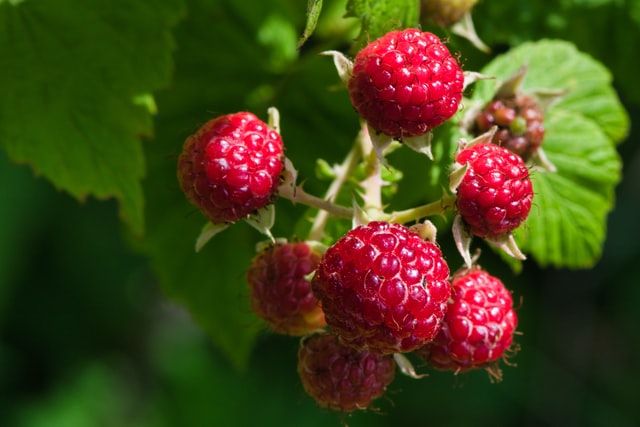
Table of Contents
What’s Eating My Raspberries?
The most common pests eating your raspberry plants are: Japanese beetles, raspberry fruit worms, weevils, spotted wing drosophila, spider mites, raspberry sawfly, raspberry cane borer, and sap beetles.
If you wandered into your raspberry patch only to find half-eaten fruits or leaves bearing the telltale signs of nibbling, you have come to the right place. Read on to find out what is eating your raspberry plants and how to get rid of them!
Related: How to Fix a Dying Raspberry Plant | Growing Raspberries Under Fruit Trees
1. Japanese Beetles
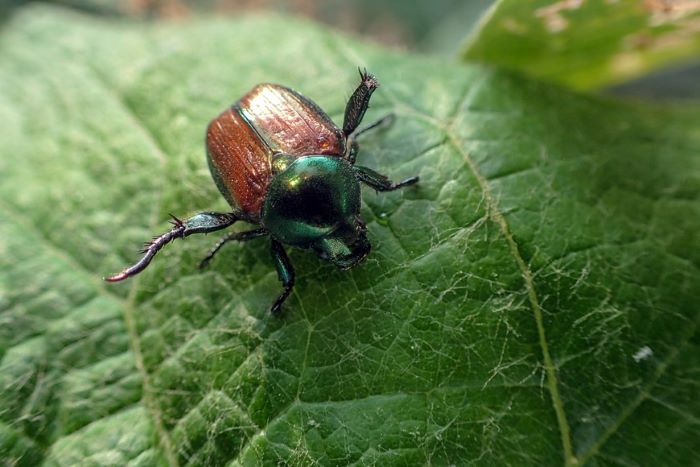
Japanese beetles are an invasive species of scarab beetle that can wreak havoc on your raspberry plants. Adult Japanese beetles are fairly easy to spot, as they have metallic green heads, and copper bodies, measuring roughly 0.6 inches long.
The larvae of the Japanese beetle are not as easily identifiable as they resemble several other species. The larvae are C-shaped white grubs with brown heads and little front legs. The only way to tell if the grubs eating your raspberry plants are, in fact, Japanese beetle larvae is by the spines and little hairs on their stomachs.
White grubs will happily munch on the root system of newly planted raspberries when they are in the larvae stage. This will severely stunt your plant’s growth.
When adult Japanese beetles infest raspberry plants, they feed voraciously on the leaves, devouring the tissue between the veins. This feeding behavior gives the leaves a lacy or skeletonized appearance. Japanese beetles will generally attack the leaves of your raspberry plant, but they will also eat your fruit.
How to Get Rid of Them: The first thing to do to get your infestation under control is to remove the Japanese beetles by hand daily. When the beetles feed on your plants, they release a chemical that attracts others, therefore, if you remove them as you see them, you stop more beetles from joining the buffet. Make sure you pick ripe raspberries as you see them.
Another way to protect your plants is by covering them with floating row covers once the flowers on your raspberry plants have bloomed. Lastly, the only other effective way to stop a Japanese beetle infestation is by applying neem oil to your plants once a week.
2. Raspberry Fruitworms
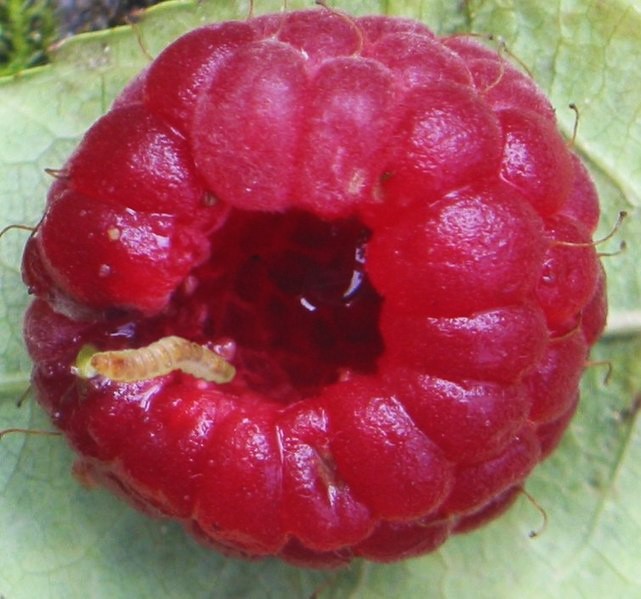
If you notice the leaves of your raspberry plants have been skeletonized, Japanese beetles may not be the only culprit. The raspberry fruit worm, also known as the larvae from the Raspberry Beetle, is another pesky garden invader that makes quick work of your raspberry plant leaves. These pests are a common nuisance for raspberry growers, myself included. In addition to skeletonized leaves, you’ll see tiny telltale holes in the flower buds.
Raspberry fruit worms are the larvae of a small, inconspicuous beetle known as Byturus unicolor. This little beetle lays its eggs on the unopened flower buds of your plant.
The larvae of these beetles are small white grubs. When they hatch, they burrow into the plant and feed on ripe raspberry fruits, causing damage and rendering the berries inedible.
How to Get Rid of Them: The best way to deal with raspberry fruit worms is to remove the adults from your plants. These little beetles are most active in the early evening, so it is best to be on the lookout for them then. Next, applying neem oil will help to control the beetles.
As with most pests, prevention is the best cure. Ensure that your garden is as free from weeds as possible. The adult beetles like to hang out on weeds, eating the pollen.
3. Weevils
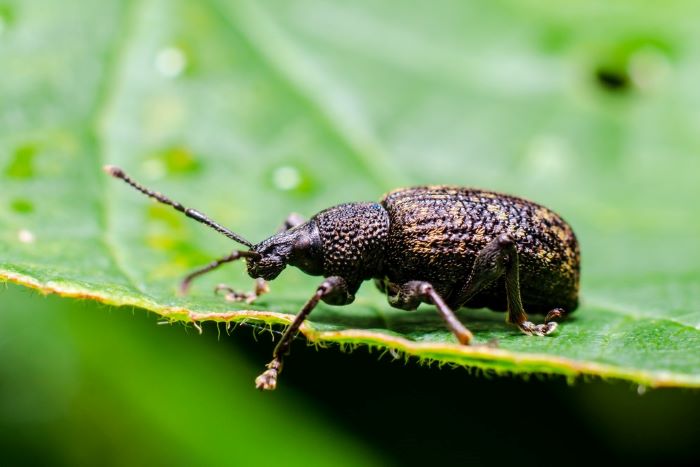
Weevils are a group of beetles belonging to the family Curculionidae that can cause damage to raspberry plants. These beetles are usually black or brown and are easy to identify because of their distinctive head shape, at the end of which is an elongated snout.
The most common weevil to bother raspberries is the Black Vine Weevil (Otiorhynchus sulcatus) but there are others in the family such as the Strawberry Root Weevil and the Rough Strawberry Root Weevil.
They are called root weevils because their larvae feast on the roots of fruit plants like raspberries and strawberries. You will notice notches in the leaves if weevils are nibbling on your raspberry plant. The stems of your plant will have been chewed on, too, by the larvae of the beetles.
How to Get Rid of Them: As with other raspberry pests, the first thing to do if you notice the rounded notches on your plants is to remove the weevils. The beetles are nocturnal, so you must do this when it’s dark.
The next step is toiling the soil to expose the larvae so birds can snatch up the little grubs. I’ve also found it helpful to add beneficial nematodes to the soil, which will attack and kill the root weevil larvae.
4. Spotted Wing Drosophila
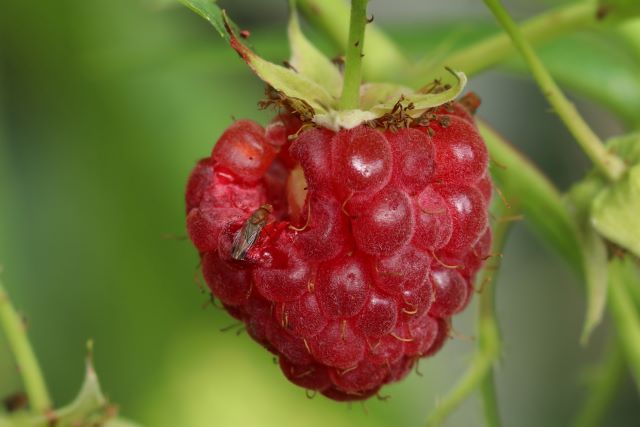
The spotted wing drosophila is a small golden fruit fly with red eyes. They lay their eggs directly into the fruit of your raspberry plants, meaning their larvae hatch and begin feeding on the fruit.
When the female spotted wing drosophila lays her eggs in the fruit, she cuts a hole in it to deposit them. This intrusion can lead to fruit rot, where your fruit begins to break down and will produce a sour smell. Although several things can cause fruit rot, it signals that your plant has been infested by spotted wing drosophila.
The first thing to look for when checking your plants for spotted wing drosophila are tiny puncture holes in your fruit. These small holes will be present before the fruit starts to break down. Look for tiny white worms in your raspberries to confirm that its spotted wing drosophila larvae are eating your raspberry plant.
How to Get Rid of Them: If your raspberry fruit has been punctured with tiny holes, remove it immediately. Removing all over-ripe fruit when you see it is best to avoid attracting more of the little fruit flies. Remember, do not put the rotting fruit into your compost heap, as this will only attract more spotted wing drosophila to your garden.
To protect your raspberry plants from spotted wing drosophila, cover them with a thin insect-proof netting.
5. Spider Mites
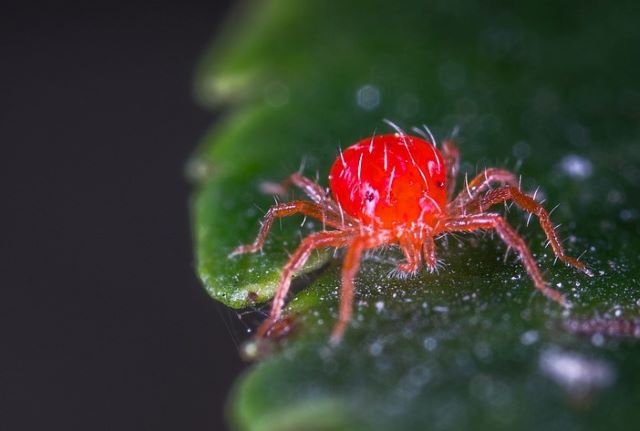
Spider mites are tiny arachnids that can wreak havoc on raspberry plants. These minuscule pests are not actual insects but belong to the spider family.
These tiny arachnids are usually found on the underside of your plant leaves, where you will find them huddled together, protected by a sticky web. They are fairly easy to spot, thanks to this! These little spiders thrive in hot weather, so be sure to watch them when the temperature rises.
If spider mites are eating your raspberry plants, you will see the leaves on your raspberry plants have a golden/brown discoloration on the leaves. This telltale sign of a spider mite problem is called ‘mite burn.’ Your plant will also start drooping, appearing unhealthy, and not producing as many raspberry fruits.
How to Get Rid of Them: I have found the easiest and most effective way to remove spider mites is with a blast of water from the garden hose. You can apply neem oil to your plants to make sure they do not return.
6. Raspberry Sawfly
The raspberry sawfly is another common raspberry pest that will reduce your leaves to mere lacy skeletons. These pests do the most damage when they are caterpillars, and although they may decimate your plant’s leaves, they leave the raspberries alone. Along with disappearing leaves, you will notice that your plant’s leaves have started to roll.
These small green caterpillars that can strip your plant’s leaves within 2 days usually hide on the underside of the leaves. Adult raspberry sawflies have black bodies, and yellow legs, with yellow spots on their head and middle.
How to Get Rid of Them: If you notice the leaves of your raspberry plant are rolling, inspect them for little green caterpillars, removing any that you see. Next, blast your plant with the garden hose to shake loose any caterpillars or eggs you may have missed.
To avoid sawfly damage to your plants, you can spread diatomaceous earth around the base so no caterpillars can reach your raspberry plant. I’ve found diatomaceous earth to be a particularly effective natural tool, which works against all persistent pests, and I apply it when planting as a precaution.
7. Raspberry Cane Borer
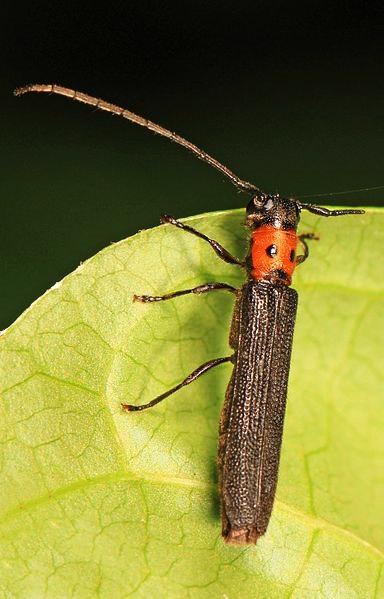
If raspberry cane borers are munching on your raspberry plant, the leaves will begin to wilt. These beetles, which are long and slim with a black body and yellowish/orange head with long antennae, bore holes into the cane of your plant to lay their eggs.
Once hatched, the larvae continue to damage your raspberry plant by boring their way down to the bottom. Once in the soil, the larvae overwinter there, emerging in spring to continue the cycle.
The damage done by this beetle is easily recognized, as they create two rings of holes roughly 6 inches from the top of the cane.
How to Get Rid of Them: If you see two distinctive rings of holes on the raspberry cane, remove the affected portion of the cane on your wilting plant. You should cut 2 inches below the holes. This should stop the larvae from boring down.
8. Sap Beetles
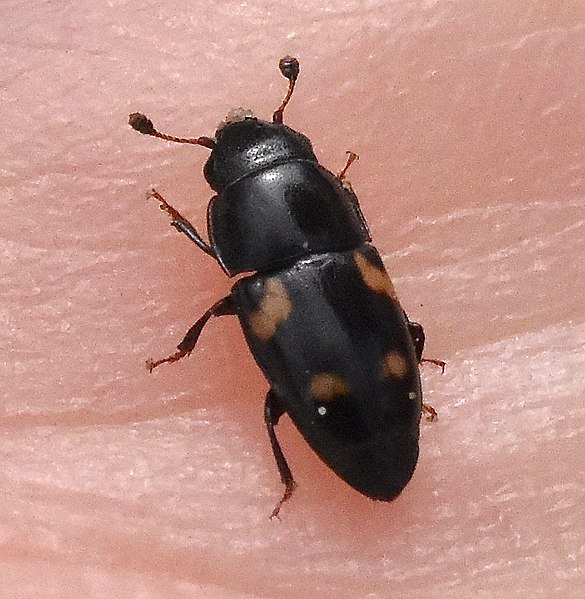
Sap beetles, also known as picnic beetles, are common, usually found on rotting fruit. They are attracted to and feed on ripe, overripe, and damaged raspberries. As these beetles feed on your raspberry plant’s fruit, they deposit their eggs.
These little beetles are a menace and cause huge damage to your raspberry fruit, rendering them inedible. They are easy to recognize because of their distinctive club-shaped antennae. If sap beetles are eating your plants, you will see holes in your fruit.
How to Get Rid of Them: Remove all overripe or rotting berries from your plant and the surrounding ground. Sadly, these beetles are usually only spotted when you go to pick your fruit, and not much can be done to save your harvest by that point. Prevention is key here.
